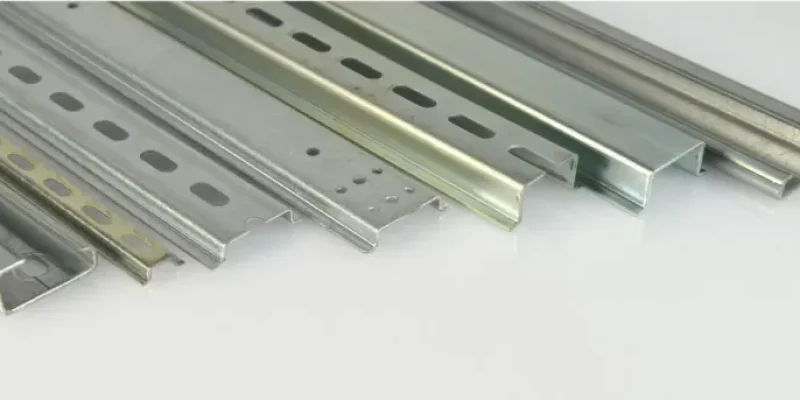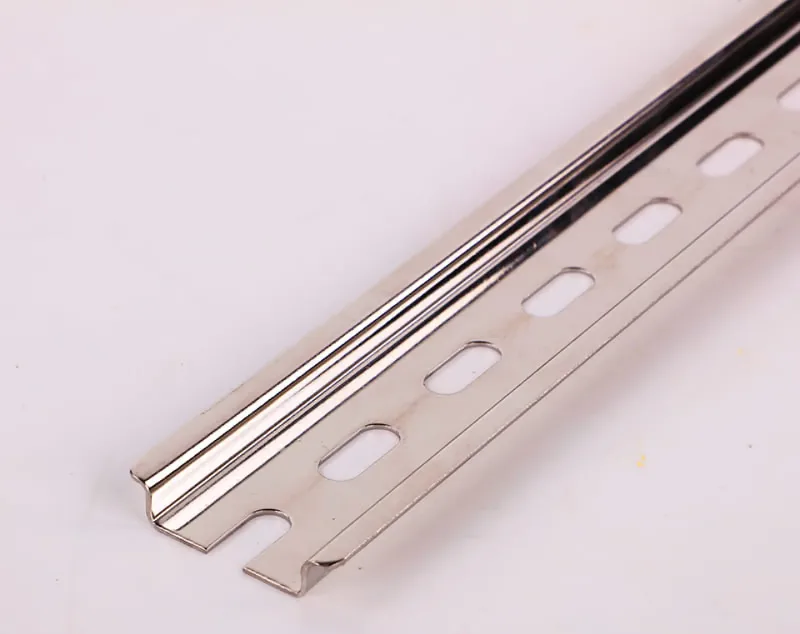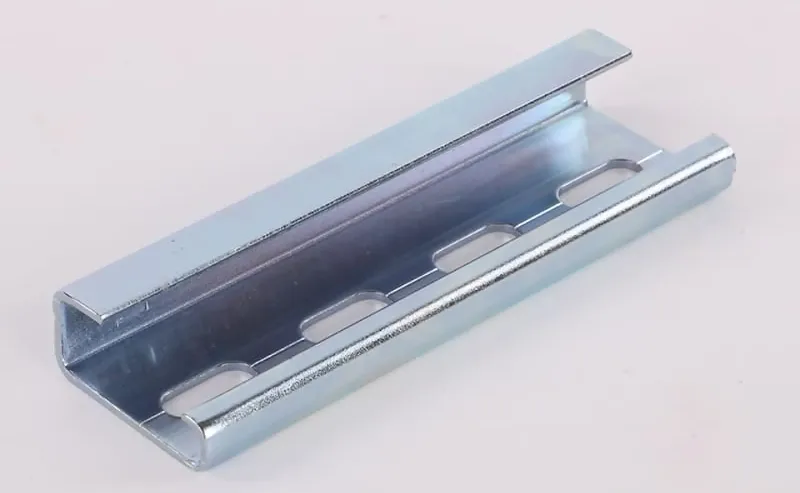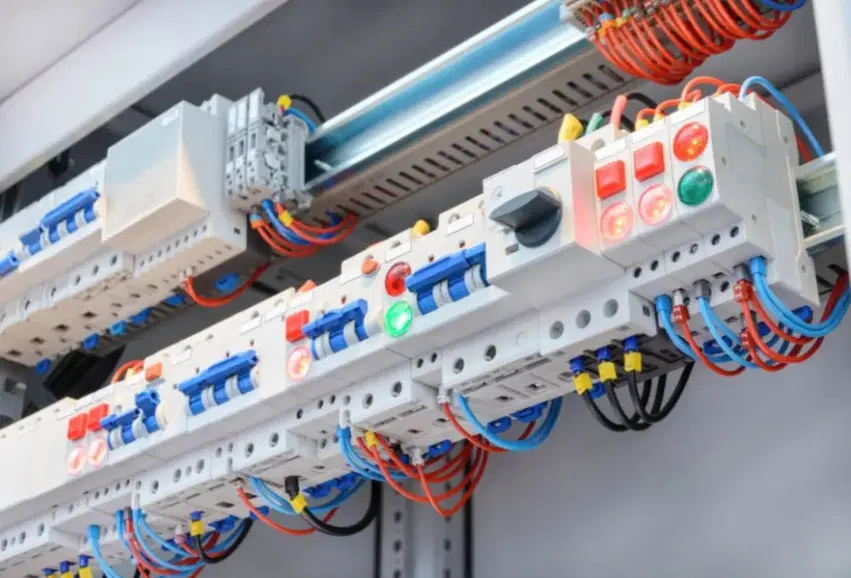DIN ரயில் என்பது உலகளவில் தொழில்துறை கட்டுப்பாட்டு பேனல்கள், மின் உறைகள் மற்றும் ஆட்டோமேஷன் அமைப்புகளில் பரவலாகப் பயன்படுத்தப்படும் ஒரு தரப்படுத்தப்பட்ட உலோக மவுண்டிங் ரயில் ஆகும். முதலில் ஜெர்மன் தரநிலைப்படுத்தல் நிறுவனத்தால் (Deutsches Institut für Normung, அல்லது DIN) உருவாக்கப்பட்டது, இந்த தண்டவாளங்கள் பல்வேறு வகையான மின் கூறுகளை பொருத்துவதற்கான உலகளாவிய தரமாக மாறியுள்ளன. நீங்கள் எப்போதாவது ஒரு மின் பேனல் அல்லது தொழில்துறை கட்டுப்பாட்டு அலமாரியின் உள்ளே பார்த்திருந்தால், செயல்பாட்டில் DIN தண்டவாளங்களைப் பார்த்திருக்கலாம் - அவை பல தொழில்களில் ஒழுங்கமைக்கப்பட்ட மின் நிறுவல்களின் முதுகெலும்பாகும்.
DIN ரயிலைப் புரிந்துகொள்வது: வரையறை மற்றும் தோற்றம்
DIN ரயில் என்றால் என்ன? அதன் மையத்தில், DIN ரயில் என்பது ஒரு தரப்படுத்தப்பட்ட உலோகப் பட்டையாகும், இது மின் மற்றும் தொழில்துறை கூறுகளுக்கான உலகளாவிய மவுண்டிங் தளமாக செயல்படுகிறது. இந்த எளிய ஆனால் தனித்துவமான தீர்வு விரைவான நிறுவல், எளிதான மறுகட்டமைப்பு மற்றும் மின் உறைகளில் இடத்தை திறமையாகப் பயன்படுத்த அனுமதிக்கிறது. தண்டவாளங்கள் பொதுவாக குளிர்-உருட்டப்பட்ட கார்பன் எஃகு தாள்களிலிருந்து தயாரிக்கப்படுகின்றன, பின்னர் அவை துரு மற்றும் அரிப்புக்கு எதிராக வலுவான பாதுகாப்பை வழங்க துத்தநாக முலாம் அல்லது குரோமேட்டிங் போன்ற மேற்பரப்பு சிகிச்சைகளுக்கு உட்படுத்தப்படுகின்றன.

DIN தரநிலைகளின் வரலாறு மற்றும் வளர்ச்சி
"DIN" என்ற சுருக்கமானது "Deutsches Institut für Normung" என்பதைக் குறிக்கிறது, இது ஜெர்மன் மொழியில் இருந்து ஜெர்மன் தரநிலைப்படுத்தல் நிறுவனம் என்று மொழிபெயர்க்கப்பட்டுள்ளது. இந்த பல்துறை மவுண்டிங் தண்டவாளங்களுக்கான தொழில்துறை விவரக்குறிப்புகளை நிறுவுவதற்கும் வரையறுப்பதற்கும் இந்த நிறுவனம் முதலில் பொறுப்பேற்றது.
DIN ரயில் என்ற கருத்து ஜெர்மனியில் வேர்களைக் கொண்டுள்ளது, அதன் முதல் அறிமுகம் 20 ஆம் நூற்றாண்டின் முற்பகுதியில் தொடங்கியது. சில கணக்குகள் இந்த அமைப்பு ஆரம்பத்தில் 1920 களின் பிற்பகுதியில் உருவாக்கப்பட்டது என்று கூறுகின்றன. அதன் வளர்ச்சியின் பின்னணியில் உள்ள முதன்மை நோக்கம் தொழில்துறை மின் கூறுகளை, குறிப்பாக மின் கட்டுப்பாட்டு சாதனங்கள் மற்றும் முனையத் தொகுதிகளை பொருத்துவதை தரப்படுத்துவதாகும்.
1920 களில், Deutsches Institut für Normung (DIN) மின் சாதனங்கள் உட்பட தொழில்துறை கூறுகளுக்கான தரநிலைகளை உருவாக்கும் முறையான செயல்முறையைத் தொடங்கியது. DIN ரயில் DIN 46277-1 போன்ற பெயர்களின் கீழ் முறையாக தரப்படுத்தப்பட்டது. ஆரம்பத்தில் ஒரு ஜெர்மன் தரநிலையாக இருந்தபோதிலும், DIN ரயில் அமைப்பின் உள்ளார்ந்த நடைமுறை மற்றும் செயல்திறன் சர்வதேச அளவில் அதன் பரவலான ஏற்றுக்கொள்ளலுக்கு வழிவகுத்தது. இந்த அமைப்பு பரந்த ஏற்றுக்கொள்ளலைப் பெற்றது மற்றும் 1950 களில் அதன் தற்போதைய பொதுவான வடிவங்களாக மேலும் உருவாக்கப்பட்டது, முதலில் அண்டை ஐரோப்பிய நாடுகளில் பரவி பின்னர் விரைவாக உலகம் முழுவதும் எடுத்துக்கொள்ளப்பட்டது.
DIN தண்டவாளங்கள் ஏன் தொழில்துறை தரநிலையாக மாறியது
பல கட்டாய காரணங்களுக்காக DIN தண்டவாளங்கள் விரைவாக பிரபலமடைந்தன:
- பல்துறைத்திறன்: வெவ்வேறு உற்பத்தியாளர்களின் கூறுகளை ஒரே தண்டவாளத்தில் பொருத்தலாம்.
- எளிமை: ஸ்னாப்-ஆன் வடிவமைப்பு சிக்கலான மவுண்டிங் வன்பொருளின் தேவையை நீக்கியது.
- செயல்திறன்: அமைப்பை தியாகம் செய்யாமல் அடர்த்தியான கூறுகளை வைக்க தண்டவாளங்கள் அனுமதிக்கப்படுகின்றன.
- நெகிழ்வுத்தன்மை: தேவைகள் மாறும்போது அமைப்புகளை எளிதாக மாற்றியமைக்கலாம் அல்லது விரிவாக்கலாம்.
இன்று, DIN தண்டவாளங்கள் அவற்றின் ஐரோப்பிய தோற்றத்தைக் கடந்து தொழில்துறை மின் மவுண்டிங் தீர்வுகளுக்கான நடைமுறை உலகளாவிய தரநிலையாக மாறியுள்ளன.
DIN தண்டவாளங்களின் வகைகள் மற்றும் அவற்றின் விவரக்குறிப்புகள்
அனைத்து DIN தண்டவாளங்களும் சமமாக உருவாக்கப்படவில்லை. இந்தத் துறை பல நிலையான சுயவிவரங்களை அங்கீகரிக்கிறது, ஒவ்வொன்றும் குறிப்பிட்ட பயன்பாடுகள் மற்றும் கூறு வகைகளுக்காக வடிவமைக்கப்பட்டுள்ளன. இந்த சுயவிவரங்கள் சர்வதேச தரங்களால் நிர்வகிக்கப்படுகின்றன, முதன்மையாக IEC/EN 60715, இது முக்கியமான பரிமாணங்கள் மற்றும் உற்பத்தி சகிப்புத்தன்மையைக் குறிப்பிடுகிறது.
டாப் தொப்பி (TS35 / TH35) DIN ரயில்
TS35 ரயில் (35மிமீ அகலம்) இதுவரை தொழில்துறை மற்றும் வணிக பயன்பாடுகளில் மிகவும் பரவலாகப் பயன்படுத்தப்படும் வகையாகும், இது உலகளவில் உள்ள அனைத்து DIN ரயில் நிறுவல்களிலும் தோராயமாக 80% ஆகும். அதன் தனித்துவமான சுயவிவரத்தின் காரணமாக பெரும்பாலும் "டாப் ஹாட்" ரயில் என்று அழைக்கப்படுகிறது, இது இரண்டு நிலையான ஆழங்களில் வருகிறது:
- 7.5மிமீ ஆழம்: பெரும்பாலான பொதுவான பயன்பாடுகளுக்கான நிலையான விருப்பம், IEC/EN 60715 இன் கீழ் முறையாக "35 × 7.5" என நியமிக்கப்பட்டுள்ளது.
- 15மிமீ ஆழம்: கனமான கூறுகள் அல்லது அதிக அதிர்வு சூழல்களுக்கான ஆழமான பதிப்பு, முறையாக "35 × 15" என நியமிக்கப்பட்டது.
இதன் வடிவம் காரணமாக, இது சில நேரங்களில் வகை O அல்லது வகை ஒமேகா (Ω) என்றும் குறிப்பிடப்படுகிறது. அமெரிக்காவில், இது பொதுவாக TS35 ரயில் என்று அழைக்கப்படுகிறது.
சி-பிரிவு (TS32) DIN ரயில்
TS32 (32மிமீ அகலம்) C-பிரிவு ரயில் ஆரம்பகால DIN ரயில் வடிவமைப்புகளில் ஒன்றாகும். இது அதன் C-வடிவ குறுக்குவெட்டால் வகைப்படுத்தப்படுகிறது மற்றும் EN 50024 போன்ற தரநிலைகளுடன் தொடர்புடையது, இருப்பினும் இந்த தரநிலை இப்போது பெரும்பாலும் ரத்து செய்யப்பட்டதாகக் குறிப்பிடப்படுகிறது. புதிய நிறுவல்களில் குறைவாகவே காணப்பட்டாலும், நீங்கள் அதை இன்னும் காணலாம்:
- மரபு அமைப்புகள் மற்றும் பழைய ஐரோப்பிய நிறுவல்கள்
- அதன் தனித்துவமான மவுண்டிங் சுயவிவரத்தைக் கோரும் சிறப்பு பயன்பாடுகள்
- சில தொலைத்தொடர்பு சாதனங்களை பொருத்தும் சூழ்நிலைகள்
சி-பிரிவு தண்டவாளங்கள் பழைய மின் நிறுவல்களில் காணப்படலாம் அல்லது குறிப்பிட்ட மரபு உபகரணங்களுக்குப் பயன்படுத்தப்படலாம். அவற்றின் சுயவிவரம் நல்ல சுவர் ஆதரவை வழங்குவதால், அவை மின்சாரம் மற்றும் மின்மாற்றிகள் போன்ற கனமான பொருட்களுக்குப் பயன்படுத்தப்படுகின்றன. இருப்பினும், சி-பிரிவு தண்டவாளங்களில் நவீன கூறுகளை பொருத்துவதற்கு பெரும்பாலும் அடாப்டரைப் பயன்படுத்த வேண்டியிருக்கும்.
ஜி-பிரிவு (TS15) DIN ரயில்
மிகச்சிறிய தரப்படுத்தப்பட்ட சுயவிவரம் TS15 (15மிமீ அகலம்) G-பிரிவு ரயில் ஆகும். G-பிரிவு DIN தண்டவாளங்கள், G32 அல்லது சில நேரங்களில் TS32 என்றும் அழைக்கப்படுகின்றன (இது C-பிரிவு TS32 உடன் குழப்பத்தை ஏற்படுத்தக்கூடும் என்றாலும்), தனித்துவமான G-வடிவ (அல்லது சில நேரங்களில் J-வகை) குறுக்குவெட்டைக் கொண்டுள்ளது. இந்த சுயவிவரம் பெரும்பாலும் ஒரு பக்கத்தில் மற்றொன்றை விட ஆழமான பள்ளத்தை உள்ளடக்கியது.
G-பிரிவு தண்டவாளங்கள் EN 50035 (சில ஆதாரங்கள் ரத்து செய்யப்பட்டதாகக் குறிப்பிடுகின்றன), BS 5825 மற்றும் அசல் DIN 46277-1 போன்ற தரநிலைகளுடன் தொடர்புடையவை. இந்த மினியேச்சரைஸ் செய்யப்பட்ட ரயில் முதன்மையாகப் பயன்படுத்தப்படுகிறது:
- இட-கட்டுப்படுத்தப்பட்ட பயன்பாடுகள்
- இலகுரக கூறு பொருத்துதல்
- சிறப்பு மின்னணு உறைகள்
இந்த தண்டவாளங்கள், வலுவான ஆதரவு மற்றும் துல்லியமான சீரமைப்பு முக்கியமான பயன்பாடுகளுக்கு குறிப்பாகத் தேர்ந்தெடுக்கப்படுகின்றன, குறிப்பாக கனரக இயந்திரங்கள், பெரிய மின் விநியோகங்கள், மின்மாற்றிகள் அல்லது அதிக இயக்கவியல் விசைகள் அல்லது அதிர்வுக்கு ஆளாகக்கூடிய பிற கணிசமான கூறுகளுக்கு. G-பிரிவு தண்டவாளத்தின் சமச்சீரற்ற வடிவமைப்பு, கூறுகளின் தவறான நிறுவலைத் தடுக்கவும் உதவும்.
DIN ரயில் பரிமாணங்கள் மற்றும் பொருள் விருப்பங்கள்
நிலையான DIN தண்டவாளங்கள் பொதுவாக இதிலிருந்து தயாரிக்கப்படுகின்றன:
- கால்வனேற்றப்பட்ட எஃகு: மிகவும் பொதுவானது, சிக்கனமான விலையில் நல்ல அரிப்பு எதிர்ப்பை வழங்குகிறது. இவை பொதுவாக குளிர்-உருட்டப்பட்ட கார்பன் எஃகு தாள்கள் ஆகும், அவை துத்தநாகத்துடன் மின்னாற்பகுப்பு முலாம் பூசப்படுகின்றன, இது பெரும்பாலும் குரோமேட் செயலற்ற செயல்முறையைத் தொடர்ந்து (தெளிவான அல்லது சில நேரங்களில் மஞ்சள் நிற பூச்சுக்கு வழிவகுக்கும்).
- துருப்பிடிக்காத எஃகு: கடுமையான சூழல்கள், உணவு பதப்படுத்துதல் அல்லது வெளிப்புற பயன்பாடுகளுக்கு. இந்த தண்டவாளங்கள் பொதுவாக உயர் தர துருப்பிடிக்காத எஃகு மூலம் தயாரிக்கப்படுகின்றன, எடுத்துக்காட்டாக AISI வகை 304 (V2A துருப்பிடிக்காத எஃகு என்றும் அழைக்கப்படுகிறது), இது அரிப்பை மிகவும் எதிர்க்கும் மற்றும் விதிவிலக்காக நீடித்தது.
- அலுமினியம்: எடை குறைப்பு முக்கியமானதாக இருக்கும்போது அல்லது குறிப்பிட்ட மின் தரையிறக்கத் தேவைகளுக்கு. அலுமினிய தண்டவாளங்கள் அவற்றின் எஃகு சகாக்களை விட கணிசமாக இலகுவானவை மற்றும் அவற்றின் மேற்பரப்பில் ஒரு பாதுகாப்பு அலுமினிய ஆக்சைடு அடுக்கின் இயற்கையான உருவாக்கம் காரணமாக நல்ல உள்ளார்ந்த அரிப்பு எதிர்ப்பைக் கொண்டுள்ளன.
தண்டவாளங்கள் பல்வேறு நீளங்களில் வருகின்றன, பொதுவாக 1-மீட்டர், 2-மீட்டர் மற்றும் தனிப்பயன்-வெட்டு விருப்பங்களில் கிடைக்கின்றன. பயன்பாட்டுத் தேவைகளைப் பொறுத்து நிலையான தடிமன் 1 மிமீ முதல் 2.3 மிமீ வரை இருக்கும்.
DIN தண்டவாளங்கள் இரண்டு முதன்மை உள்ளமைவுகளிலும் கிடைக்கின்றன:
- திடமான (துளையிடப்படாத): அதிக உள்ளார்ந்த விறைப்புத்தன்மை மற்றும் இயந்திர வலிமையை வழங்குகிறது, குறிப்பிடத்தக்க அதிர்வுக்கு உள்ளாகும் பயன்பாடுகளுக்கு அல்லது குறிப்பாக கனமான கூறுகளுக்கு வலுவான ஆதரவு தேவைப்படும் இடங்களில் விரும்பப்படுகிறது.
- துளையிடப்பட்ட (துளையிடப்பட்ட): முன்-இயந்திர துளைகள் அல்லது நீளமான துளைகளைக் கொண்டுள்ளது, அவை பொருத்துவதற்கு அதிகரித்த நெகிழ்வுத்தன்மையை வழங்குகின்றன மற்றும் எளிதான வயரிங் மற்றும் கேபிள் நிர்வாகத்தை எளிதாக்கும்.
செயல்பாட்டில் DIN தண்டவாளங்கள்: தொழில்கள் முழுவதும் பரந்த அளவிலான பயன்பாடுகள்
DIN ரயில் அமைப்புகளின் பல்துறை திறன், தரப்படுத்தல் மற்றும் செயல்திறன் ஆகியவை குறிப்பிடத்தக்க வகையில் பல்வேறு தொழில்கள் மற்றும் பயன்பாடுகளில் அவற்றை பரவலாக ஏற்றுக்கொள்ள வழிவகுத்தன. கனரக தொழில்துறை உற்பத்தி முதல் அதிநவீன கட்டிட ஆட்டோமேஷன் மற்றும் வளர்ந்து வரும் புதுப்பிக்கத்தக்க எரிசக்தி தொழில்நுட்பங்கள் வரை, முக்கியமான மின் மற்றும் மின்னணு கூறுகளை ஒழுங்கமைப்பதற்கும் ஏற்றுவதற்கும் DIN தண்டவாளங்கள் ஒரு பொதுவான முதுகெலும்பை வழங்குகின்றன.
தொழில்துறை ஆட்டோமேஷன் மற்றும் உற்பத்தி கட்டுப்பாட்டு பலகைகள்
இது DIN தண்டவாளங்களுக்கான ஒரு மைய மற்றும் பாரம்பரிய பயன்பாட்டுப் பகுதியாகும். இயந்திரங்கள், உற்பத்தி கோடுகள் மற்றும் முழு செயல்முறை கட்டுப்பாட்டு அமைப்புகளையும் நிர்வகிக்கும் கட்டுப்பாட்டு அலமாரிகள் மற்றும் பேனல்களுக்குள் அவை விரிவாகப் பயன்படுத்தப்படுகின்றன. பொதுவாக பொருத்தப்பட்ட கூறுகளில் நிரல்படுத்தக்கூடிய லாஜிக் கன்ட்ரோலர்கள் (PLCகள்), அவற்றுடன் தொடர்புடைய உள்ளீடு/வெளியீடு (I/O) தொகுதிகள், மோட்டார் கட்டுப்படுத்திகள் (VFDகள் மற்றும் மென்மையான தொடக்கிகள் போன்றவை), ரிலேக்கள், தொடர்புகள், பல்வேறு சென்சார்கள், இடைமுக தொகுதிகள் மற்றும் மின் விநியோகங்கள் ஆகியவை அடங்கும். நவீன ஆட்டோமேஷன் அமைப்புகளின் சிக்கலான தன்மை மற்றும் நம்பகத்தன்மை தேவைகளுக்கு அவசியமான ஒழுங்கமைக்கப்பட்ட, உயர் அடர்த்தி மற்றும் எளிதில் சேவை செய்யக்கூடிய தளவமைப்புகளை உருவாக்க DIN தண்டவாளங்கள் உதவுகின்றன. அவை மோட்டார் கட்டுப்பாட்டு மையங்கள் (MCCகள்), செயல்முறை கட்டுப்பாட்டு பேனல்கள் மற்றும் இயந்திர பாதுகாப்பு அமைப்புகளுக்கு அடிப்படையானவை.
ஆற்றல் மேலாண்மை, விநியோகம் மற்றும் புதுப்பிக்கத்தக்க ஆற்றல் அமைப்புகள்
எரிசக்தி துறையில், மின் விநியோக பேனல்களுக்கு DIN தண்டவாளங்கள் இன்றியமையாதவை, அங்கு அவை சர்க்யூட் பிரேக்கர்கள் (MCBகள், MCCBகள்), எரிசக்தி மீட்டர்கள், மின்னோட்ட மின்மாற்றிகள் மற்றும் முனைய விநியோகத் தொகுதிகளை ஏற்றுகின்றன. வீட்டுப் பாதுகாப்பு ரிலேக்கள் மற்றும் கட்டுப்பாட்டு உபகரணங்களுக்கான துணை மின் நிலையக் கட்டுப்பாட்டு அலமாரிகளிலும் அவை முக்கியமான கூறுகளாகும். புதுப்பிக்கத்தக்க எரிசக்தி அமைப்புகளில் குறிப்பிடத்தக்க மற்றும் வளர்ந்து வரும் பயன்பாட்டுப் பகுதி உள்ளது. சூரிய மின் நிறுவல்களுக்கு, ஃபோட்டோவோல்டாயிக் (PV) இன்வெர்ட்டர்கள், சார்ஜ் கன்ட்ரோலர்கள், பேட்டரி மேலாண்மை அமைப்புகள் (BMS), சர கண்காணிப்பு சாதனங்கள் மற்றும் DC துண்டிப்புகளை ஏற்ற DIN தண்டவாளங்கள் பயன்படுத்தப்படுகின்றன. இதேபோல், காற்றாலை மின் அமைப்புகளில், அவை கட்டுப்பாடு மற்றும் கண்காணிப்பு கூறுகளை ஆதரிக்கின்றன.
நுண்ணறிவு கட்டிடங்கள்: HVAC, விளக்குகள் மற்றும் பாதுகாப்பு கட்டுப்பாடுகள்
நவீன கட்டிட ஆட்டோமேஷன் மற்றும் மேலாண்மை அமைப்புகளில் (BMS) DIN தண்டவாளங்கள் பரவலாகப் பயன்படுத்தப்படுகின்றன. வெப்பமாக்கல், காற்றோட்டம் மற்றும் ஏர் கண்டிஷனிங் (HVAC) அமைப்புகள், லைட்டிங் கட்டுப்பாடுகள் (மங்கலானவை மற்றும் திட்டமிடல் அலகுகள் உட்பட) மற்றும் பாதுகாப்பு அமைப்புகள் (அணுகல் கட்டுப்பாடு மற்றும் அலாரம் பேனல்கள் போன்றவை) நிர்வகிக்கும் கட்டுப்படுத்திகள், ரிலேக்கள், டைமர்கள், சென்சார்கள் மற்றும் இடைமுக தொகுதிகளுக்கு ஏற்ற உள்கட்டமைப்பை அவை வழங்குகின்றன. DIN தண்டவாளங்கள் வழங்கும் மட்டுப்படுத்தல் நெகிழ்வான மற்றும் அளவிடக்கூடிய கட்டிடக் கட்டுப்பாட்டு தீர்வுகளை அனுமதிக்கிறது.
தொலைத்தொடர்பு உள்கட்டமைப்பு மற்றும் தரவு மையங்கள்
தொலைத்தொடர்பு உள்கட்டமைப்பு மற்றும் தரவு மையங்களுக்குள், நெட்வொர்க் உபகரண ரேக்குகள், தகவல் தொடர்பு மையங்கள் மற்றும் விநியோக பிரேம்களில் DIN தண்டவாளங்கள் பயன்படுத்தப்படுகின்றன. அவை பேட்ச் பேனல்கள், ஃபைபர் ஆப்டிக் டெர்மினேஷன் பாக்ஸ்கள் மற்றும் தொகுதிகள், சிறிய தொழில்துறை தர நெட்வொர்க் சுவிட்சுகள், மீடியா மாற்றிகள் மற்றும் சிறிய மின் விநியோகங்கள் போன்ற கூறுகளை ஏற்றுகின்றன. தொலைத்தொடர்பு அலமாரிகள் மற்றும் உறைகளுக்குள் அடிக்கடி கடுமையான இடக் கட்டுப்பாடுகள் இருப்பதால், இந்த பயன்பாடுகளில் மினியேச்சர் DIN தண்டவாளங்கள் (TS15) குறிப்பாக சாதகமாக உள்ளன.
போக்குவரத்து அமைப்புகள் (ரயில், கடல், தானியங்கி)
போக்குவரத்துத் துறையும் DIN ரயில் அமைப்புகளைப் பயன்படுத்துகிறது. அவை ரயில்வே சிக்னலிங் அமைப்புகள், ஆன்-போர்டு ரயில் கட்டுப்பாட்டு பெட்டிகள் மற்றும் போக்குவரத்து கட்டுப்பாட்டு அமைப்புகளில் காணப்படுகின்றன. கடல் பயன்பாடுகளில், வழிசெலுத்தல், தகவல் தொடர்பு மற்றும் கட்டுப்பாட்டு அமைப்புகளுக்கான மின் பேனல்களில் DIN தண்டவாளங்கள் பயன்படுத்தப்படுகின்றன, அங்கு உப்பு நீர் சூழல்களில் அவற்றின் மேம்பட்ட அரிப்பு எதிர்ப்பிற்காக துருப்பிடிக்காத எஃகு அல்லது அலுமினியம் போன்ற பொருட்கள் பெரும்பாலும் தேர்ந்தெடுக்கப்படுகின்றன. கட்டுப்பாட்டு மின்னணுவியல் மற்றும் பாதுகாப்பு சாதனங்களை ஏற்றுவதற்கான மின்சார வாகன (EV) சார்ஜிங் உள்கட்டமைப்பிலும் அவை அதிகமாகக் காணப்படுகின்றன.
குடியிருப்பு மின் நிறுவல்கள்
பாரம்பரியமாக தொழில்துறை மற்றும் வணிக அமைப்புகளில் மிகவும் பொதுவானதாக இருந்தாலும், நவீன குடியிருப்பு மின் விநியோக பலகைகளில் (நுகர்வோர் அலகுகள்) DIN தண்டவாளங்கள் அதிகளவில் பயன்படுத்தப்படுகின்றன. அவை மினியேச்சர் சர்க்யூட் பிரேக்கர்கள் (MCBகள்), மீதமுள்ள மின்னோட்ட சாதனங்கள் (RCDகள்), அதிகப்படியான மின்னோட்ட பாதுகாப்புடன் கூடிய மீதமுள்ள மின்னோட்ட பிரேக்கர்கள் (RCBOகள்), எழுச்சி பாதுகாப்பு சாதனங்கள் மற்றும் சில நேரங்களில் ஸ்மார்ட் ஹோம் தொகுதிகள் ஆகியவற்றை ஏற்றுவதற்கு நேர்த்தியான மற்றும் தரப்படுத்தப்பட்ட வழியை வழங்குகின்றன. TS35 ரயில், பொதுவாக துத்தநாகம் பூசப்பட்ட எஃகிலிருந்து தயாரிக்கப்பட்ட 7.5 மிமீ ஆழ பதிப்பாகும், அதன் இட திறன், பரந்த கூறு பொருந்தக்கூடிய தன்மை மற்றும் செலவு-செயல்திறன் காரணமாக இந்த பயன்பாடுகளில் பொதுவானது.
DIN ரயில் சுற்றுச்சூழல் அமைப்பு: பொருத்தப்பட்ட சாதனங்கள் மற்றும் அத்தியாவசிய பாகங்கள்
செயல்பாட்டு, பாதுகாப்பான மற்றும் நன்கு ஒழுங்கமைக்கப்பட்ட DIN ரயில் அசெம்பிளியை முடிப்பதற்கு விரிவான அளவிலான துணைக்கருவிகள் மிக முக்கியமானவை. இந்த துணைக்கருவிகள் அமைப்பின் திறன்களையும் பயன்பாட்டின் எளிமையையும் மேம்படுத்துகின்றன. முக்கிய துணைக்கருவிகள் பின்வருமாறு:
முனை அடைப்புக்குறிகள் / முனை கவ்விகள் / அடைப்பான்கள்
இவை DIN தண்டவாளத்தில் கூறுகளைப் பாதுகாப்பதற்கும், குறிப்பாக அதிர்வுக்கு உட்பட்ட சூழல்களில் அல்லது போக்குவரத்தின் போது எந்தவொரு பக்கவாட்டு இயக்கம் அல்லது இடப்பெயர்ச்சியைத் தடுப்பதற்கும் இன்றியமையாதவை. அவை பொதுவாக பொருத்தப்பட்ட சாதனங்களின் வரிசையின் இரு முனைகளிலும் வைக்கப்படுகின்றன. எடுத்துக்காட்டுகளில் பீனிக்ஸ் காண்டாக்ட் CLIPFIX 35-5 மற்றும் E/NS 35 N எண்ட் பிராக்கெட்டுகள் அடங்கும்.
எண்ட் கேப்கள் / பிரிப்பான்கள் / பார்ட்டிஷன் பிளேட்டுகள்
சில வகையான முனையத் தொகுதிகளின் வெளிப்படும் கடத்தும் பக்கங்களை மூடுவதற்கு எண்ட் கேப்கள் பயன்படுத்தப்படுகின்றன, இது பாதுகாப்பை மேம்படுத்துகிறது. பிரிப்பான் அல்லது பகிர்வு தகடுகள் வெவ்வேறு தொகுதி கூறுகள் அல்லது முனையத் தொகுதிகளை உடல் ரீதியாகவும் மின்சார ரீதியாகவும் தனிமைப்படுத்தப் பயன்படுகின்றன, எடுத்துக்காட்டாக, வெவ்வேறு மின்னழுத்தங்கள் அல்லது செயல்பாடுகளின் சுற்றுகளைப் பிரிக்க.
ஜம்பர்கள் / பாலங்கள் (நிலையான அல்லது காப்பிடப்பட்ட)
இவை ஒரு முனையத் தொகுதி அசெம்பிளிக்குள் அருகிலுள்ள முனையங்களை மின்சாரம் மூலம் இணைக்கப் பயன்படுகின்றன, இதனால் மின் விநியோகம் அல்லது சமிக்ஞை பொதுவான தன்மைக்கான பொதுவான ஆற்றல்கள் உருவாக்கப்படுகின்றன. குறுகிய இணைப்புகளுக்கு தனிப்பட்ட கம்பிகளைப் பயன்படுத்துவதை விட அவை மிகவும் நம்பகமான மற்றும் சுத்தமான இணைப்பை வழங்குகின்றன.
குறியிடும் அமைப்புகள் / லேபிள்கள் / குறிச்சொற்கள்
கூறுகள், முனையத் தொகுதிகள், தனிப்பட்ட முனையங்கள் மற்றும் தொடர்புடைய வயரிங் ஆகியவற்றை அடையாளம் காண தெளிவான மற்றும் நிலையான லேபிளிங் அவசியம். இது நிறுவல், ஆணையிடுதல், சரிசெய்தல் மற்றும் பராமரிப்பு ஆகியவற்றில் பெரிதும் உதவுகிறது. குறியிடும் அமைப்புகளில் ஒட்டும் லேபிள்கள், ஸ்னாப்-ஆன் பிளாஸ்டிக் மார்க்கர்கள், அச்சிடக்கூடிய மார்க்கர் ஸ்ட்ரிப்கள் அல்லது பொறிக்கப்பட்ட தகடுகள் ஆகியவை அடங்கும். லேபிள்கள் சாதன எண்கள், மின்னழுத்தம்/மின்னோட்ட மதிப்பீடுகள், செயல்பாடுகள் அல்லது பாதுகாப்பு எச்சரிக்கைகளைக் குறிக்கலாம்.
ஆதரவு அடைப்புக்குறிகள் / நிறுத்தங்கள்
இவை DIN தண்டவாளத்திற்கு கூடுதல் ஆதரவை வழங்கப் பயன்படுத்தப்படலாம், குறிப்பாக நீண்ட இடைவெளிகளுக்கு அல்லது குறிப்பாக கனமான கூறுகளை ஏற்றும்போது. வயரிங் அல்லது ஆழமான கூறுகளுக்கு அதிக இடத்தை உருவாக்க, DIN தண்டவாளத்தை மவுண்டிங் மேற்பரப்பில் இருந்து உயர்த்தவும் அவற்றைப் பயன்படுத்தலாம். STS தொடரின் DIN ரயில் ஆதரவு அடைப்புக்குறிகள் ஒரு எடுத்துக்காட்டு.
DIN ரயில் நிறுவலின் சிறந்த நடைமுறைகள்
சரியான நிறுவல் DIN ரயில் அமைப்புகளின் நம்பகத்தன்மை மற்றும் நீண்ட ஆயுளை உறுதி செய்கிறது.
DIN ரயில் நிறுவலுக்குத் தேவையான கருவிகள் மற்றும் பொருட்கள்
அடிப்படை DIN ரயில் நிறுவலுக்கு பொதுவாக தேவைப்படும்வை:
- உலோக வெட்டும் கருவிகள் (தனிப்பயன் நீளங்களுக்கு) - சுத்தமான, சதுரமான, பர்-இல்லாத வெட்டுக்களை வழங்குவதால், சிறப்பு DIN ரயில் கட்டர்கள் மிகவும் பரிந்துரைக்கப்படுகின்றன.
- தண்டவாளம் நேராக பொருத்தப்பட்டுள்ளதா என்பதை உறுதி செய்ய, ஸ்பிரிட் லெவல் உள்ளிட்ட அளவிடும் கருவிகள்.
- துளையிடும் உபகரணங்கள் மற்றும் பொருத்தமான ஃபாஸ்டென்சர்கள்
- இறுதி நிறுத்த நிறுவல் கருவிகள்
- கூறு குறியிடும் கருவிகள்
குறிப்பிட்ட ரயில் வகைகள் அல்லது மவுண்டிங் சூழல்களுக்கு கூடுதல் சிறப்பு கருவிகள் தேவைப்படலாம்.
படிப்படியான நிறுவல் செயல்முறை
ஒரு முறையான DIN ரயில் நிறுவல் இந்த பொதுவான படிகளைப் பின்பற்றுகிறது:
- அனைத்து கூறுகளுக்கும் போதுமான இடத்தை உறுதிசெய்து, அமைப்பை அளந்து திட்டமிடுங்கள்.
- தேவைப்பட்டால் தண்டவாளத்தை தேவையான நீளத்திற்கு வெட்டுங்கள்.
- தண்டவாளத்தை பலகை அல்லது உறையில் பாதுகாப்பாக ஏற்றவும், அது சரியாக சமமாகவும் நேராகவும் இருப்பதை உறுதிசெய்யவும்.
- பொருத்தமான இடங்களில் இறுதி நிறுத்தங்களை நிறுவவும்.
- திட்டமிடப்பட்ட உள்ளமைவில் கூறுகளை தண்டவாளத்தில் பொருத்தவும்.
- அமைப்பின் வடிவமைப்பின் படி வயரிங் இணைக்கவும்.
- எதிர்கால குறிப்புக்காக கூறுகள் மற்றும் வயரிங் லேபிளிடுங்கள்.
இந்த முறையான அணுகுமுறையைப் பின்பற்றுவது சுத்தமான, தொழில்முறை நிறுவலை உறுதி செய்கிறது.
தவிர்க்க வேண்டிய பொதுவான நிறுவல் தவறுகள்
அனுபவம் வாய்ந்த நிறுவிகள் கூட சில நேரங்களில் இந்த பிழைகளை செய்கிறார்கள்:
- கூறுகளுக்கு இடையில் போதுமான இடைவெளி இல்லாததால், வெப்பப் பிரச்சினைகள் ஏற்படுகின்றன.
- போதுமான தண்டவாளப் பாதுகாப்பு இல்லாமை, இயக்கம் மற்றும் சாத்தியமான தோல்விகளுக்கு வழிவகுக்கும்.
- வெவ்வேறு ரயில் வகை தேவைகளுடன் பொருந்தாத கூறுகளைக் கலத்தல்.
- எதிர்கால விரிவாக்கத்திற்கான மோசமான திட்டமிடல்
- போதுமான லேபிளிங் இல்லாதது, பராமரிப்பு சிக்கல்களை உருவாக்குகிறது.
- தண்டவாளங்களின் தவறான சீரமைப்பு, இது கூறுகளை ஆன் அல்லது ஆஃப் செய்வதை கடினமாக்கும்.
- குறிப்பிட்ட எடை வரம்புகளுக்கு மேல் தண்டவாளங்களை ஓவர்லோட் செய்தல்
இந்த ஆபத்துகளைத் தவிர்ப்பது மிகவும் நம்பகமான மற்றும் பராமரிக்கக்கூடிய நிறுவல்களுக்கு வழிவகுக்கிறது.
DIN ரயில் மவுண்டிங் சிஸ்டங்களைப் பயன்படுத்துவதன் நன்மைகள்
DIN ரயில் தொழில்நுட்பத்தின் பரவலான ஏற்றுக்கொள்ளல் அதன் ஏராளமான நடைமுறை நன்மைகளிலிருந்து உருவாகிறது.
விண்வெளி திறன் மற்றும் நிறுவன நன்மைகள்
DIN ரயில் பொருத்துதல் வழங்குகிறது:
- பேனல் இடத்தின் அதிகபட்ச பயன்பாடு
- தருக்க கூறு தொகுத்தல் மற்றும் அமைப்பு
- உகந்த குளிரூட்டலுக்கான தரப்படுத்தப்பட்ட இடைவெளி
- சுத்தமான, தொழில்முறை தோற்றம்
இந்தப் பண்புக்கூறுகள் இட-கட்டுப்படுத்தப்பட்ட பயன்பாடுகளில் குறிப்பாக மதிப்புமிக்கவை.
நெகிழ்வுத்தன்மை மற்றும் அளவிடுதல் நன்மைகள்
DIN ரயில் அமைப்புகள் தகவமைப்புத் திறனில் சிறந்து விளங்குகின்றன:
- கூறுகளை எளிதாகச் சேர்க்கலாம், அகற்றலாம் அல்லது இடமாற்றம் செய்யலாம்
- தேவைகள் விரிவடையும் போது அமைப்புகள் படிப்படியாக வளரக்கூடும்.
- முழுமையான மறு நிறுவல் இல்லாமல் தொழில்நுட்பங்களை மேம்படுத்தலாம்.
- தரப்படுத்தல் பல விற்பனையாளர்களிடமிருந்து கூறுகளை ஒருங்கிணைக்க அனுமதிக்கிறது.
இந்த நெகிழ்வுத்தன்மை தொழில்துறை மற்றும் வணிக அமைப்புகளுக்கான மொத்த வாழ்க்கைச் சுழற்சி செலவுகளைக் குறைக்கிறது.
பராமரிப்பு மற்றும் மாற்றீட்டின் எளிமை
சேவை தேவைப்படும்போது, DIN ரயில் மவுண்டிங் பிரகாசிக்கிறது:
- அருகிலுள்ள சாதனங்களுக்கு இடையூறு விளைவிக்காமல் குறைபாடுள்ள கூறுகளை மாற்றலாம்.
- முழுமையான மாற்றீடு இல்லாமல் அமைப்புகளை ஓரளவு மேம்படுத்தலாம்.
- ஒழுங்கமைக்கப்பட்ட தளவமைப்பு மூலம் சரிசெய்தல் எளிமைப்படுத்தப்படுகிறது.
- தரப்படுத்தப்பட்ட கூறுகள் உதிரி பாகங்கள் சரக்கு தேவைகளைக் குறைக்கின்றன.
இந்த பராமரிப்பு நன்மைகள் நேரடியாக குறைக்கப்பட்ட வேலையில்லா நேரம் மற்றும் குறைந்த சேவை செலவுகளுக்கு வழிவகுக்கும்.
உங்கள் விண்ணப்பத்திற்கு சரியான DIN ரயிலைத் தேர்ந்தெடுப்பது
பொருத்தமான DIN ரயிலைத் தேர்ந்தெடுப்பது பல முக்கியமான பரிசீலனைகளை உள்ளடக்கியது.
DIN தண்டவாளங்களைத் தேர்ந்தெடுக்கும்போது கருத்தில் கொள்ள வேண்டிய முக்கிய காரணிகள்
முடிவெடுக்கும் காரணிகளில் பின்வருவன அடங்கும்:
- கூறு இணக்கத்தன்மை: அனைத்து சாதனங்களும் நீங்கள் தேர்ந்தெடுத்த ரயில் வகையை ஆதரிப்பதை உறுதிசெய்யவும்.
- சுமை தேவைகள்: கூறுகளின் எடை மற்றும் எண்ணிக்கையைக் கருத்தில் கொள்ளுங்கள்.
- சுற்றுச்சூழல் நிலைமைகள்: வெப்பநிலை, ஈரப்பதம், அரிப்பு ஆபத்து மற்றும் அதிர்வு
- ஒழுங்குமுறை இணக்கம்: தொழில் சார்ந்த தரநிலைகள் மற்றும் தேவைகள்
- நிறுவல் கட்டுப்பாடுகள்: கிடைக்கும் இடம் மற்றும் பொருத்துதல் விருப்பங்கள்
- பொருள் தேர்வு: பயன்பாட்டு சூழலுக்கு ஏற்ப பொருத்தமான பொருளை (எஃகு, அலுமினியம், துருப்பிடிக்காத எஃகு) தேர்வு செய்யவும்.
- ரயில் கட்டமைப்பு: உங்கள் குறிப்பிட்ட தேவைகளுக்கு திடமான (துளையிடப்படாத) அல்லது துளையிடப்பட்ட (துளையிடப்பட்ட) தண்டவாளங்கள் மிகவும் பொருத்தமானவையா என்பதைத் தீர்மானிக்கவும்.
இந்த காரணிகளை சமநிலைப்படுத்துவது உகந்த கணினி செயல்திறன் மற்றும் நம்பகத்தன்மைக்கு வழிவகுக்கிறது.
தொழில் சார்ந்த தேவைகள்
வெவ்வேறு துறைகள் தனித்துவமான DIN ரயில் பரிசீலனைகளைக் கொண்டுள்ளன:
- உணவு மற்றும் பானங்கள்: துப்புரவுத் தேவைகள் மற்றும் துப்புரவுப் பொருட்களுக்கு எதிர்ப்புத் திறன் கொண்ட துருப்பிடிக்காத எஃகு தண்டவாளங்கள்.
- போக்குவரத்து: அதிக அதிர்வுகளைத் தாங்கும் மவுண்டிங் அமைப்புகள், அதிகபட்ச விறைப்புத்தன்மைக்கு பெரும்பாலும் திடமான தண்டவாளங்கள் தேவைப்படுகின்றன.
- அபாயகரமான இடங்கள்: சிறப்பு தரையிறக்கம் மற்றும் பொருள் தேவைகள்
- வெளிப்புற நிறுவல்கள்: அரிப்பை எதிர்க்கும் பொருட்கள் மற்றும் வானிலை எதிர்ப்பு
- கடல் சூழல்கள்: உப்பு நீர் சூழல்களில் மேம்படுத்தப்பட்ட அரிப்பு எதிர்ப்பிற்கான துருப்பிடிக்காத எஃகு அல்லது அலுமினிய தண்டவாளங்கள்.
- எடை உணர்திறன் பயன்பாடுகள்: போக்குவரத்து உபகரணங்களுக்கான அலுமினிய தண்டவாளங்கள் (ரயில், விண்வெளி, வாகனம்)
இந்த சிறப்புத் தேவைகளைப் புரிந்துகொள்வது பொருத்தமான ரயில் தேர்வை உறுதி செய்கிறது.
உங்கள் DIN ரயில் நிறுவல் எதிர்காலத்திற்கு ஏற்றது
நாளைய தேவைகளுக்கான திட்டமிடலில் பின்வருவன அடங்கும்:
- எதிர்கால விரிவாக்கத்திற்கு கூடுதல் ரயில் இடத்தை அனுமதித்தல்
- வளர்ந்து வரும் கூறு தொழில்நுட்பங்களைக் கருத்தில் கொண்டு
- மட்டு வடிவமைப்பு கொள்கைகளை செயல்படுத்துதல்
- நிறுவல் விவரங்களை முழுமையாக ஆவணப்படுத்துதல்
- பரந்த அளவிலான கூறுகளை ஆதரிக்கும் தண்டவாளங்களைத் தேர்ந்தெடுப்பது.
இந்த தொலைநோக்கு சிந்தனை அணுகுமுறைகள் DIN ரயில் நிறுவல்களின் பயனுள்ள ஆயுளை நீட்டிக்கின்றன.
டின் ரயில் உற்பத்தி வீடியோ
முடிவு: நவீன மின் அமைப்புகளில் DIN தண்டவாளங்களின் நீடித்த மதிப்பு
தொழில்துறை வரலாற்றில் மிகவும் வெற்றிகரமான தரப்படுத்தல் முயற்சிகளில் ஒன்றை DIN ரயில் தொழில்நுட்பம் பிரதிபலிக்கிறது. 20 ஆம் நூற்றாண்டின் முற்பகுதியில் ஒரு ஜெர்மன் முயற்சியாகத் தொடங்கியது, தொழில்கள், பயன்பாடுகள் மற்றும் தொழில்நுட்பங்களைத் தாண்டிய உலகளாவிய தரமாக உருவாகியுள்ளது. ஒரு தேசிய விவரக்குறிப்பிலிருந்து சர்வதேச மின் நடைமுறையின் ஒரு மூலக்கல்லாக அதன் பயணம், உலகளாவிய பொறியியல் சவால்களை எதிர்கொள்ள நன்கு சிந்திக்கப்பட்ட, நடைமுறை மற்றும் தரப்படுத்தப்பட்ட தீர்வின் சக்தியை அடிக்கோடிட்டுக் காட்டுகிறது.
DIN ரயில் அமைப்பின் நீடித்த வெற்றிக்கு முக்கிய நன்மைகளின் சங்கமமே காரணமாக இருக்கலாம். அதன் முதன்மையான பங்களிப்பு, இது கொண்டு வரும் தரப்படுத்தல் ஆகும், இது உலகளவில் எண்ணற்ற உற்பத்தியாளர்களிடமிருந்து கூறுகளுக்கு இடையில் இயங்கக்கூடிய தன்மையை உறுதி செய்கிறது. இது கூறு தேர்வில் பல்துறைத்திறன் மற்றும் அமைப்பு வடிவமைப்பு மற்றும் மாற்றத்தில் நெகிழ்வுத்தன்மைக்கு வழிவகுக்கிறது. இந்த அமைப்பு மிகவும் ஒழுங்கமைக்கப்பட்ட நிறுவல்களை ஊக்குவிக்கிறது, இது பேனல்களுக்குள் குறிப்பிடத்தக்க இடத் திறனுக்கும் குழப்பத்தைக் குறைப்பதற்கும் வழிவகுக்கிறது. இந்த அமைப்பு, கூறுகளை தண்டவாளத்தில் பொருத்தும் எளிமையுடன் இணைந்து, நிறுவல் மற்றும் செயல்பாட்டுக்கு வரும்போது கணிசமான நேரம் மற்றும் செலவு மிச்சப்படுத்துகிறது.
அதன் வெளிப்படையான எளிமை - வெறும் உலோகத் துண்டு - இருந்தபோதிலும், DIN ரயில் நவீன மின் பேனல் கட்டிடம் மற்றும் தொழில்துறை ஆட்டோமேஷன் வடிவமைப்பின் ஒரு மூலக்கல்லாகும். சிக்கலான உற்பத்தி கட்டுப்பாட்டு அமைப்புகள் முதல் அறிவார்ந்த கட்டிட மேலாண்மை மற்றும் புதுப்பிக்கத்தக்க எரிசக்தி நிறுவல்கள் வரை பரந்த அளவிலான பயன்பாடுகளில் சிக்கலான தன்மையை எளிமைப்படுத்துதல், மட்டுப்படுத்தலை வளர்ப்பது மற்றும் செயல்திறனை மேம்படுத்துதல் ஆகியவற்றிலிருந்து அதன் முக்கிய பங்கு உருவாகிறது.
IoT-இயக்கப்பட்ட சாதனங்களின் ஒருங்கிணைப்பு போன்ற புதிய தொழில்நுட்பங்களுக்கு DIN ரயில் அமைப்பின் தகவமைப்புத் தன்மை மற்றும் பல்வேறு தொழில்களுக்கு அதன் பொருத்தம் ஆகியவை அதன் மாறும் தன்மையை எடுத்துக்காட்டுகின்றன மற்றும் எப்போதும் வளர்ந்து வரும் தொழில்நுட்ப நிலப்பரப்பில் அதன் தொடர்ச்சியான பொருத்தத்தை உறுதி செய்கின்றன. பொருட்கள், உற்பத்தி நுட்பங்கள் மற்றும் தரநிலைகளில் நடந்து வரும் பரிணாமம் புதிய சவால்கள் மற்றும் வாய்ப்புகளுக்கு பதிலளிக்கக்கூடிய ஒரு அமைப்பை மேலும் சுட்டிக்காட்டுகிறது.
தொழில்துறை கட்டுப்பாடுகள், மின் அமைப்புகள் அல்லது ஆட்டோமேஷன் தொழில்நுட்பத்தில் பணிபுரியும் எவருக்கும் DIN ரயில் என்றால் என்ன, அதை எவ்வாறு சரியாக செயல்படுத்துவது என்பதைப் புரிந்துகொள்வது அவசியமான அறிவு. நீங்கள் ஒரு புதிய நிறுவலை வடிவமைத்தாலும் சரி அல்லது ஏற்கனவே உள்ள ஒன்றைப் பராமரித்தாலும் சரி, நவீன மின் அமைப்புகள் கட்டமைக்கப்படுவதற்கு எளிய DIN ரயில் தொடர்ந்து முதுகெலும்பாக அமைகிறது.
தொடர்புடையது
சரியான DIN தண்டவாளங்களை எவ்வாறு தேர்வு செய்வது: முழுமையான வழிகாட்டி
DIN ரயில் vs. பாரம்பரிய மவுண்டிங்
DIN ரயில் விலைகளை பாதிக்கும் முக்கிய காரணிகள்: ஒரு விரிவான பகுப்பாய்வு
நவீன மின் நிறுவல்களில் DIN தண்டவாளங்கள் ஏன் அவசியம் என்பதற்கான முதல் 5 காரணங்கள்






